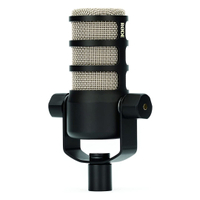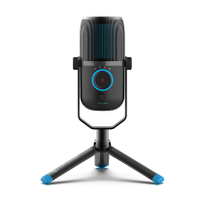Whereas the best USB microphones are all about keeping things simple, for podcasting it can be worth choosing a mic that’s either more specialized or more advanced generally: when your product consists of nothing but your voice, you’d better make it sound as good as you can. And let’s not forget some other audio hardware essentials, many of which are listed on our best headphones, best laptops, and best webcams guides. Keep building your audio setup with the help of our guides to the best computer speakers, the best gaming microphones, and the best streaming microphones while also spending less. Read on, then, for our picks of the best podcasting microphones that we’ve tested ourselves and don’t forget to check out our guide to the best microphones overall.
Top 3 best podcasting microphones
The best podcasting microphones you can buy right now
The PodMic is small, but overflowing with high-quality recording capability. While serious podcasters should always fine-tune their recordings before publishing, one of the best things about the PodMic is that it doesn’t take much setup to get it sounding crisp and clear in the first place. Not in the pure audio sense, anyway; you will need to buy a stand separately, and the XLR cable won’t simply plug into any laptop or PC. But the microphone itself is cheap enough that you can spend more on stands and interfaces, with the ultimate result of superior sound quality to that of many more expensive USB microphones. Read our full Rode PodMic review. Where there’s a discussion of outstanding microphones, the Blue Yeti is never far away. We rate this user-friendly mic highly for just about anything that involves voice recording, and it’s just at home on a podcast as it is on a gaming stream or Skype call. In addition to working well in cardioid mode — that’s when the mic only records the area directly in front of it — the Blue Yeti also offers bidirectional, omnidirectional and stereo recording patterns. These can give you some extra flexibility with your podcast formats, as you could record interviews or panel discussions with a single microphone. Read our full Blue Yeti review. The JLab Talk has stuck around the sub-$80 mark for a while now. If this holds, it’s a fantastic deal on what was already a solid USB mic when it launched at $99. Like the Blue Yeti, it’s child’s play to set up and use, and you even get the same four recording patterns to play with. We also like the adjustable tripod stand and the combined gain/volume dial, which glows blue or green depending on which level you’re adjusting. If you need to buy multiple microphones for guests and co-hosts, the Talk is an extremely cost-effective choice. Read our full JLab Talk review. So far we’ve seen several great-value podcasting mics, but what if you can spare some extra change? Check out the Blue Yeti X: a bigger, upgraded version of the crowd-pleasing Yeti. Among the improvements are front-mounted gain controls, so you don’t need to reach around the back to make adjustments, and an onboard level meter that makes it much easier to check your settings are how you like them. These might not sound like major differences, considering how much cheaper the standard Blue Yeti is, but in a live recording situation these extra tools can help you make on-the-fly corrections. This, in turn, could save you editing time later. Read our full Blue Yeti X review. The Elgato Wave: 3 is neither a dedicated podcaster’s mic nor a true generalist like the Blue Yeti or JLab Talk. How, then, is it one of the best podcasting microphones? For starters, it’s a very good-sounding cardioid mic, with an almost retro look that fits in well with any studio space. More importantly, its streaming focus could actually translate into podcast effectiveness. It’s designed to work in conjunction with the Elgato Stream Deck, a multi-button console used by streamers to make sound adjustments while they’re live; you could easily adapt this setup to work for podcasting, with the Stream Deck simplifying your mic controls so that you can focus on discussions and banter. Read our full Elgato Wave: 3 review. The UM700 is another solid all-rounder. It’s a more affordable take on the Blue Yeti formula, though build quality hasn’t suffered for it, and you can flick between different recording patterns should you need to record a group conversation without multiple microphones. Sound quality is fine — you may need to touch up recordings when editing, but that should be normal practice if you want your podcast sounding professional. You get a full set of onboard controls too, including a mute button and a gain dial. Give the UM700 a shot if you want Yeti-style design at an even lower price. Read our full Movo UM700 review. Like the Wave: 3, the QuadCast S’s podcasting credentials could be considered a happy accident: whereas the Elgato mic was built for streaming, HyperX’s is primarily concerned with gaming. As if the light-up RGB grille wasn’t enough of a giveaway. Even so, there’s plenty here for regular podcasters. The QuadCast S sounds great with minimal setup, can be easily mounted to a boom arm or other custom stand and includes some handy bonus features that could save you money on accessories. These include a shock mount, which quietens down any accidental bumps the mic might take while recording, and a built-in pop filter for cleaner-sounding speech. Read our full HyperX QuadCast S review. If you find the QuadCast S a little too ostentatious, you’ll probably appreciate the sharp lines and stylish stand of the EPOS B20. This USB microphone covers all the essentials (like onboard gain control) and adds birdirectional, omnidirection and stereo recording patterns. These all work well, especially the bidirectional mode, though it’s the cardioid mode that’s best for solo recording. To wrangle the maximum potential out of the B20, be sure to download and install the EPOS Gaming Suite. And don’t be fooled by the name: its collection of tools, which includes a noise gate control, can help the most serious podcasts sound as good as the hardware will permit. Read our full EPOS B20 review.
How to choose the best podcasting microphone for you
Audio quality Recording quality is a vital quality for any type of microphone, but it’s easily the most important attribute of any podcasting mic. You could probably get away with a bit of fuzziness or gain imbalance for the odd gaming session, but in a voice-only medium like podcasting, you should only demand the best. Even then you should be prepared for some audio editing once recording is complete, but by choosing one of the models above you can at least minimize the effort required in the post-production stage. Recording patterns Consider also the format of your podcast, and how your recording hardware will need to fit. If you’re only recording yourself speaking to remote-connecting guests, all you need is a mic with a cardioid recording pattern; this is also fine, if not ideal, for in-person group recordings where everyone has the luxury of their own microphone. If you can only budget for a single mic, you’ll need one that can record in wider patterns. Bidirectional modes let you record one person directly in front and one person directly behind the mic, so it’s suited for one-on-one chats. An omnidirectional pattern should be used when there are multiple speakers encircled around a single mic, while a stereo pattern is ideal for when several speakers are lined up in front of the mic. This won’t record everyone at equal volume, hence requiring some editing later, but you’ll get a sense of where individual speakers are positioned. Contributions from: James Archer, Marshal Honorof
How we test the best podcasting microphones
We test microphones using similar methods to how you’d record and produce a podcast: speaking into the mic, using different recording patterns if there are any, and listening back to hear how it sounds and whether any post-production editing would be required. To get to the recording stage we also need to set up and configure each microphone, which again reflects what their owners will eventually need to do. We’ll let you know in each mic’s full review, all of which are linked above, if this process is particularly easy or difficult. Once we complete our testing, we rate Bluetooth speakers based on our five-point system (1 = worst, 5 = best). If a product is truly exemplary, it’s awarded an Editor’s Choice.


















